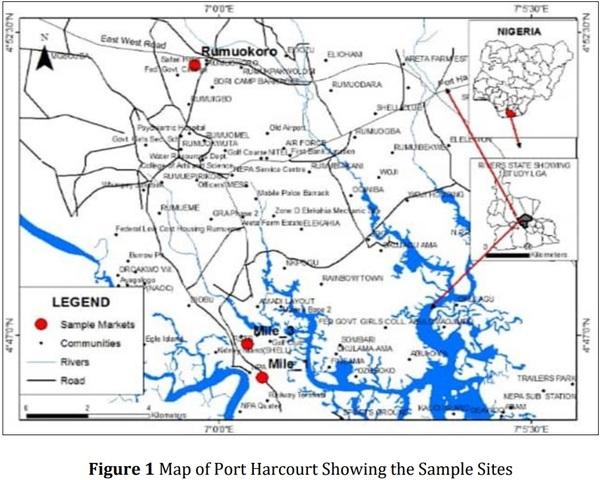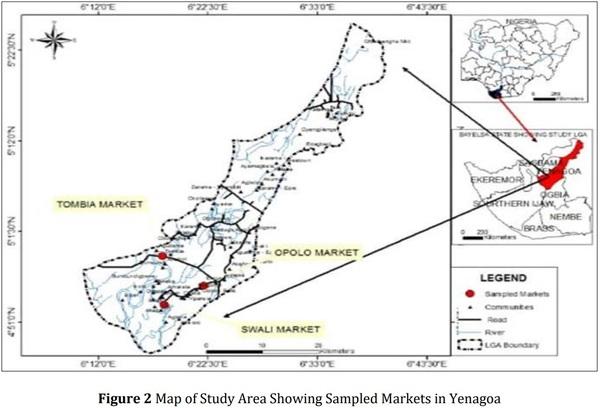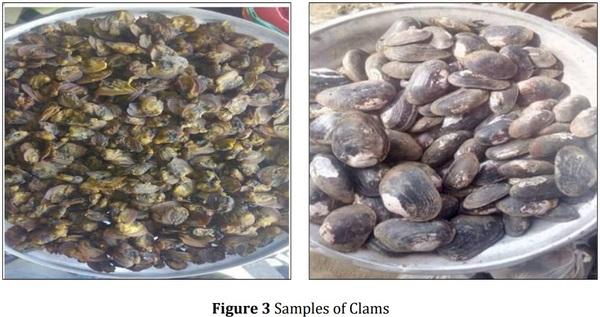1. Introduction
Over the years, water pollution has become one of the major environmental challenges facing most of the states in Southern Nigeria, particularly the Niger Delta region. Niger Delta is one of the most prominent regions in Nigeria with vast aquatic ecosystems greatly blessed with variety of fish species both Fin and Shell fishes [1]. Amongst other states in the region, Rivers and Bayelsa State coastal waters are faced with massive environmental pollutions due to increased coastal population, rapid urbanization, oil and gas explorations, heavy rainfall throughout the year and other array of anthropogenic activities which are capable of deteriorating the aquatic ecosystem [2, 3]. Most of these activities generate wastes that bear heavy metals that cause environmental degradation and oftentimes, these heavy metals which are non-biodegradable, accumulate in organs and tissues of aquatic organisms like Clams, Oysters and Cockles through their diets and respiration, thereby posing a serious health risk to human and other animals when consumed [4]. Therefore, it is important to evaluate the levels of heavy metals in shellfishes like Clam, sold in major open markets in Port Harcourt and Yenagoa because of anthropogenic activities prominent in these areas.
Heavy metals are known as metallic elements that have a relatively high density compared to water, and they include Cadmium (Cd), Chromium (Cr), Lead (Pb), Nickel (Ni), Zinc (Zn) and other potentially hazardous elemental forms [5]. The environmental impacts of heavy metals have become a subject of public concern as a result of their hard consequences [6]. Globally, heavy metals are known for their toxicity, non-biodegradability, bioaccumulation tendency and persistency in the ecosystem [7]. All these put together, make the metals dangerous, hence their toxins contribute to a variety of adverse health effects [8], and unfortunately, fish food is one main channel through which heavy metals enters into human body [9].
Fish is one major source of food protein of animal origin for the population across the globe, providing both saturated and unsaturated fatty acids, liposoluble vitamins and essential minerals which are associated with health benefits and normal growth [10, 11]. Freshwater Clam has been one edible shellfish that is essential to man and widely eaten for its proteineous and mineral content [12]. Egeria radiata are found around the mangrove swamp mudflats and are known as accumulator of heavy metals, which have been widely used as bio-indicator for monitoring and evaluating pollution in aquatic ecosystem [13, 3].
It is against this backdrop that the study on investigation of heavy metal levels of Clams sold in open markets in Port Harcourt and Yenagoa was conducted, as results obtained from the study will serve as baseline information for researchers, health experts and regulatory agencies.
2. Material and methods
2.1. Description of Study Area
The study was carried out in two contiguous states of Rivers and Bayelsa as shown in Fig. 1 & 2
2.1.1. Location 1: Port Harcourt
Port Harcourt is one of the largest cities in the Niger Delta region, serving as the administrative capital of Rivers State (see Fig 1). It is a hub of both industrial and commercial activities in southern Nigeria with prominent oil and gas companies operating in many parts of the city. The city of Port Harcourt plays host to the popular Rumuokoro, Mile 1 and Mile 3 markets. Port Harcourt lies between Latitude 4º45'N and 4º55'N and Longitude 6º55'E and 7º05'E, bounded in the North by Imo and Abia States, in the East by Akwa-Ibom state, in the West by Bayelsa state and in the South by the Atlantic Ocean[14]. It has an estimated population of over 1,865000 inhabitants.
2.1.2. Location 2: Yenagoa
Yenagoa was the second location for this study. It is the administrative capital of Bayelsa state and it lies between Latitude 4º55'N and Longitude 6º15'E. The city of Yenagoa is known for the array of anthropogenic activities such as oil exploration, sand dredging, artisanal fishing and mechanic shops, abattoir businesses and others marketing activities. It has a total land mass of 706km2, with a population estimated to be over 352,282. Yenagoa plays host to the popular Tombia, Swali and Opolo markets as shown in Fig. 2.
2.2. Sample Collection
Samples of Clams (see Fig. 3) were collected from three open markets in Port Harcourt, Rivers State and Yenagoa, Bayelsa State. The samples were collected bi-weekly for the period of three months at Mile 1 market and coded as (PM 1), Rumuokoro market (PM 2) and Mile 3 market as (PM 3) for easy identification. The samples of clams collected from open markets in Yenagoa were obtained from Opolo market and coded as (YM 1), Swali market (YM 2) and Tombia market as (YM 3). The dried samples procured from each of these markets were kept in isolated containers and then transported to the laboratory for analysis.
2.3. Sample Analysis
Samples of freshwater Clams collected were placed in a folded aluminum foil and dried in an air-circulating oven for 3 to 4 days at a temperature above 50ºC until a dry weight was achieved before metal analysis. The entire dried samples of Clams were then used for acid digestion. For digestion, the dried powdered samples were measured in a 50 ml tube then transferred to 250 ml conical flask, thereafter, 3 ml of concentrated acid was added to the sample in the flask and transferred to the digestion tube where it was heated for about 15-20 minutes for the hot plate to bring the metals into solution. The digestion was stopped and cooled, and after cooling, the solution was sieved using a Whatman 42 filter paper in a 50 ml volumetric flask. Distilled water was added to make mark and it was then conveyed to a 100 ml Can for heavy metal(Cr, Cd and Pb) analysis using flame atomic absorption spectrophotometer(AAS), Perkin-Elmer Analyst 300. All the samples obtained from each site, were analyzed in triplicates for accurate result.
2.4. Statistical analysis
The statistical data were analyzed using one-way analysis of variance with the aid of computer software (Microsoft Excel and SPSS version 21).
3. Results and discussion
The results of heavy metal concentrations of samples collected from open markets in Port Harcourt and Yenagoa, are shown in Table 1


The samples of Clams from Mile 1 market (PM1) contained all the tested heavy metals in the increasing order of Cr, Pb and Cd ranging from 0.066 ± 0.001 mg/kg to 0.78 ± 0.000.The samples of Clams collected from Rumuokoro market (PM2) also contained all the tested heavy metals; Cd, Cr and Pb in the following increasing order: Cr, Pb and Cd, ranging from 0.080 ± 0.004 mg/kg to 0.54 ± 0.0002 mg/kg. The results of heavy metals in samples obtained from Mile 3 market (PM3), showed that all the tested metals were present in the following increasing order, Cr, Pb and Cd ranging from 0.036 ± 0.006 to 0.61 ± 0.00 mg/kg. The results of heavy metal concentrations in samples collected from markets in Yenagoa, showed that samples procured from Opolo market (YM1) contained all the tested metals in the following increasing order; Cd, Pb and Cr, ranging from 0.032 ± 0.002 Mg/Kg to 0.040 ± 0.001 mg/kg. Also, the results of samples collected from Swali market (YM2), showed that all the tested heavy metals were present in the increasing order of Cd, Pb and Cr ranging from 0.035 ± 0.00 Mg/Kg to 0.043 ± 0.003 mg/kg. Samples procured from Tombia market (YM3), showed that all the tested heavy metals were present in the following increasing order; Pb, Cr and Cd, ranging from 0.040 ± 0.020 mg/kg to 0.044 ± 0.001 mg/kg.
The results of heavy metal concentrations of Clams sold in open markets in Port Harcourt and Yenagoa, as shown in Table 1, revealed that the levels of Chromium were higher in samples collected from Rumuokoro and Mile 1 in Port Harcourt, compared to all the samples procured from Yenagoa that had almost the same range of mean values. Although, there was no significant difference (p˃0.05) between mean values of samples collected from both Port Harcourt and Yenagoa, in terms of chromium level. The values of Cr obtained across the sample sites were below the World Health Organisation permissible limit shown in Table 2 and poses no health risk for consumers. This finding is similar to the observation of [4], that Cr is a non-essential metal required in small amount for the biological activities of organisms, but is in variance with the findings of [12], who reported of higher concentrations of Cr in Egeria radiata from creeks in Burutu area of Delta state, due to oil pollution. According to [15], higher concentrations of Cr above 5 mg/kg, is capable of causing skin irritation and ulceration in short exposure, and mutation and cell damage for a long exposure.
The obtained results in the present study revealed that Cd mean values for samples obtained from open markets in Port Harcourt were significantly high compared to the ones procured from markets in Yenagoa. The Cd concentrations in samples obtained across sites in Port Harcourt, were above WHO permissible limits shown in Table 2, while samples obtained across markets in Yenagoa, fell below the WHO standard for human consumption. These findings observed across open markets in Port Harcourt is similar to that of [12] who attributed higher Cd concentrations in fresh water Clams to array of anthropogenic activities like oil and gas exploration. Cadmium as a non-essential micro-nutrient, even in minute form is still toxic and consumption of food with Cd is hazardous to human health [16].
The heavy metal concentrations of Clams sampled from open markets in Port Harcourt and Yenagoa, as shown in Table 1, revealed that samples procured from Port Harcourt had higher levels of Lead (Pb) than those sampled from Yenagoa, with samples from Rumuokoro market (PM2) recording the highest mean value, while samples obtained from Opolo market (YM1) in Yenagoa, had the lowest mean value. The levels of Pb in samples across the stations were below the standard limits set by W.H.O. Although, Pb is one heavy metal that is toxic with no nutritional value to living organism and no amount of Lead is considered safe for food [17].
4. Conclusion
Generally, the results of the study revealed that all the tested heavy metals of Clams were present at varying levels across the sample stations, which is an indication of heavy metals contamination of the aquatic ecosystems in Port Harcourt and Yenagoa areas of Niger Delta. The concentrations of heavy metal were more in samples procured from markets in Port Harcourt than that of samples obtained in Yenagoa, and this could be attributed to dominance of oil and gas exploration, Chemical industries, abattoir, mechanic workshops, pipeline vandalism and other anthropogenic activities in Port Harcourt than Yenagoa. Therefore, there is need to monitor, assess and evaluate the aquatic ecosystem in Rivers and Bayelsa states routinely, to forestall further heavy metals contaminations in order to reduce the health risks to the barest minimum.
This article was originally published in World Journal of Advanced Research and Reviews, 2021, 11(03), 109–114. This is an Open Access article published under the terms of the Creative Commons Attribution License 4.0. 








.jpg&w=3840&q=75)